Marketing: Consumer Behavior and Cultural Influences in Tourism
VerifiedAdded on 2022/10/19
|15
|4026
|439
Report
AI Summary
This report examines consumer behavior within the tourism industry, emphasizing the impact of culture on the customer decision process. It begins with an introduction highlighting the increasing importance of understanding customer behavior in a competitive global market, particularly in retaining customers and building loyalty. The report analyzes the purchase situation and target market, focusing on the tourism sector and the benefits it offers, such as stress relief and work-life balance. It segments the customer profiles based on demographics, income, and age, with a specific focus on the youth demographic. The report then explores the influencing factors on the consumer decision process, with a detailed analysis of the impact of culture. Finally, the paper provides strategic marketing recommendations for improving the management of customer behavior within the tourism industry. The report references several academic articles to support its findings.
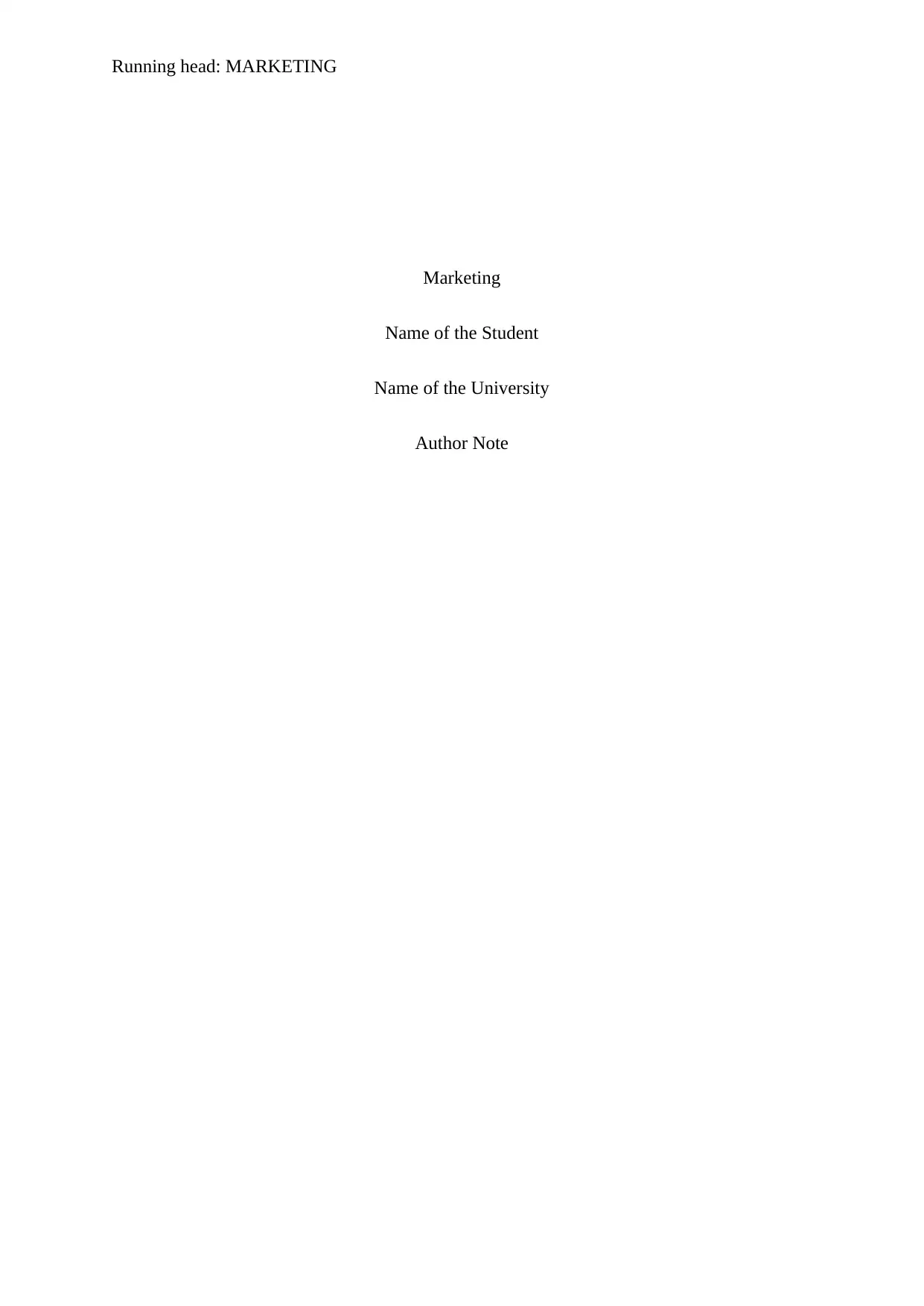
Running head: MARKETING
Marketing
Name of the Student
Name of the University
Author Note
Marketing
Name of the Student
Name of the University
Author Note
Paraphrase This Document
Need a fresh take? Get an instant paraphrase of this document with our AI Paraphraser

1MARKETING
Table of Contents
Introduction:...............................................................................................................................3
Purchase Situation and Target Market Profile:..........................................................................4
Influencing Factors on the Consumer Decision Process:...........................................................8
Recommendations:...................................................................................................................11
Conclusion:..............................................................................................................................11
References:...............................................................................................................................13
Table of Contents
Introduction:...............................................................................................................................3
Purchase Situation and Target Market Profile:..........................................................................4
Influencing Factors on the Consumer Decision Process:...........................................................8
Recommendations:...................................................................................................................11
Conclusion:..............................................................................................................................11
References:...............................................................................................................................13
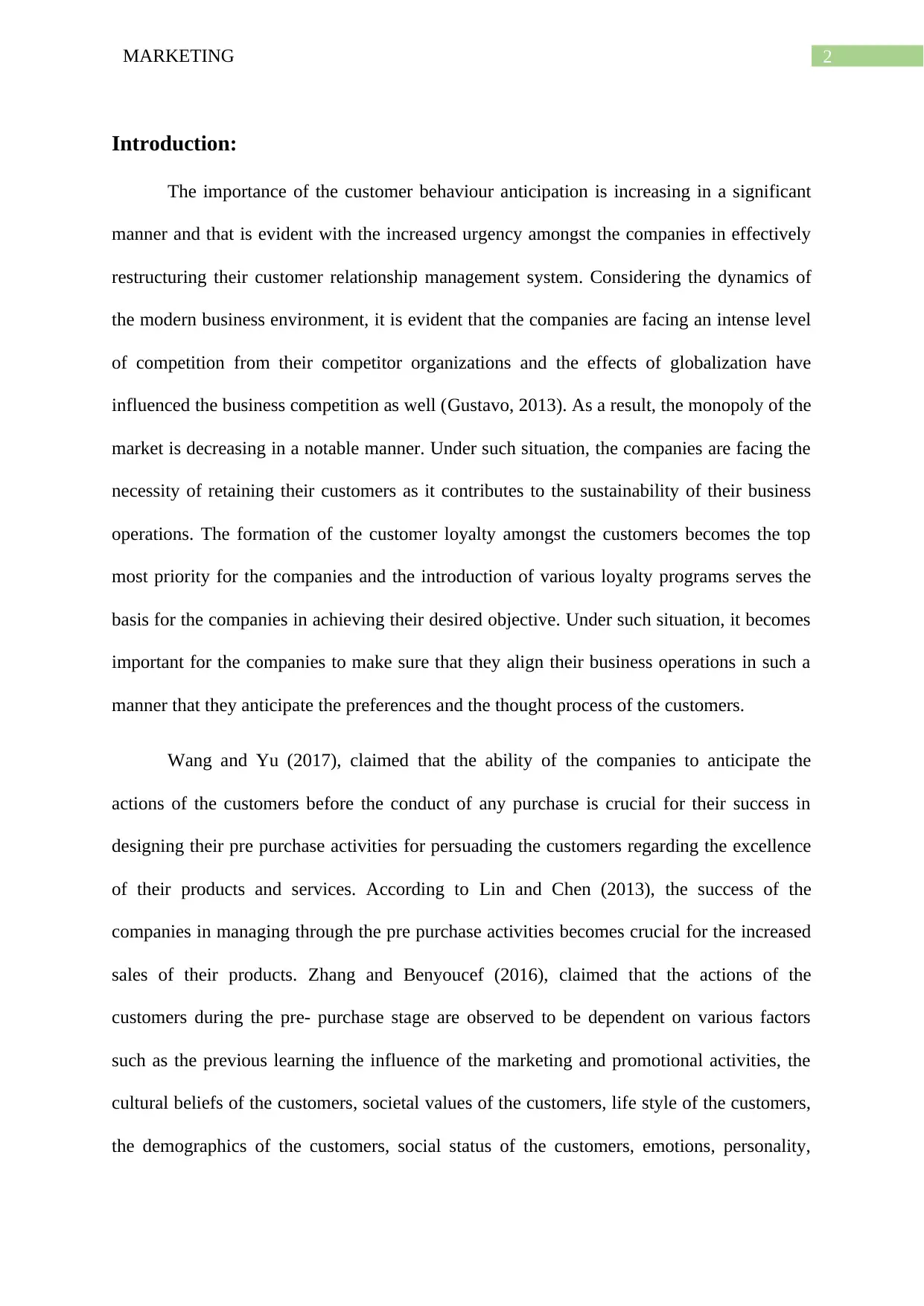
2MARKETING
Introduction:
The importance of the customer behaviour anticipation is increasing in a significant
manner and that is evident with the increased urgency amongst the companies in effectively
restructuring their customer relationship management system. Considering the dynamics of
the modern business environment, it is evident that the companies are facing an intense level
of competition from their competitor organizations and the effects of globalization have
influenced the business competition as well (Gustavo, 2013). As a result, the monopoly of the
market is decreasing in a notable manner. Under such situation, the companies are facing the
necessity of retaining their customers as it contributes to the sustainability of their business
operations. The formation of the customer loyalty amongst the customers becomes the top
most priority for the companies and the introduction of various loyalty programs serves the
basis for the companies in achieving their desired objective. Under such situation, it becomes
important for the companies to make sure that they align their business operations in such a
manner that they anticipate the preferences and the thought process of the customers.
Wang and Yu (2017), claimed that the ability of the companies to anticipate the
actions of the customers before the conduct of any purchase is crucial for their success in
designing their pre purchase activities for persuading the customers regarding the excellence
of their products and services. According to Lin and Chen (2013), the success of the
companies in managing through the pre purchase activities becomes crucial for the increased
sales of their products. Zhang and Benyoucef (2016), claimed that the actions of the
customers during the pre- purchase stage are observed to be dependent on various factors
such as the previous learning the influence of the marketing and promotional activities, the
cultural beliefs of the customers, societal values of the customers, life style of the customers,
the demographics of the customers, social status of the customers, emotions, personality,
Introduction:
The importance of the customer behaviour anticipation is increasing in a significant
manner and that is evident with the increased urgency amongst the companies in effectively
restructuring their customer relationship management system. Considering the dynamics of
the modern business environment, it is evident that the companies are facing an intense level
of competition from their competitor organizations and the effects of globalization have
influenced the business competition as well (Gustavo, 2013). As a result, the monopoly of the
market is decreasing in a notable manner. Under such situation, the companies are facing the
necessity of retaining their customers as it contributes to the sustainability of their business
operations. The formation of the customer loyalty amongst the customers becomes the top
most priority for the companies and the introduction of various loyalty programs serves the
basis for the companies in achieving their desired objective. Under such situation, it becomes
important for the companies to make sure that they align their business operations in such a
manner that they anticipate the preferences and the thought process of the customers.
Wang and Yu (2017), claimed that the ability of the companies to anticipate the
actions of the customers before the conduct of any purchase is crucial for their success in
designing their pre purchase activities for persuading the customers regarding the excellence
of their products and services. According to Lin and Chen (2013), the success of the
companies in managing through the pre purchase activities becomes crucial for the increased
sales of their products. Zhang and Benyoucef (2016), claimed that the actions of the
customers during the pre- purchase stage are observed to be dependent on various factors
such as the previous learning the influence of the marketing and promotional activities, the
cultural beliefs of the customers, societal values of the customers, life style of the customers,
the demographics of the customers, social status of the customers, emotions, personality,
⊘ This is a preview!⊘
Do you want full access?
Subscribe today to unlock all pages.

Trusted by 1+ million students worldwide

3MARKETING
motives along with the perception of the customers. The paper is focused in the evaluation of
the impact of one of these factors which is culture on the buyer behaviour off the customers.
Along with that, the selected service for the consideration of the buyer behaviour is tourism
activities. The paper portrays the dynamics of the customer behaviour process and evaluates
the impact of the culture of the customers on the process. With a precise focus on the
findings, the paper provides an important strategic marketing recommendation for the much
required improvement in the management of the customer behaviour process to be
implemented by the relevant companies.
Purchase Situation and Target Market Profile:
The selected service for the paper is tourism. The importance of the tourism activities
amongst the people of the modern generation is considerable and that is evident with the
growth of the mentioned industry in recent years. With a precise consideration towards the
fast and hectic life style of the individuals, it is evident that the tourism activities provide the
much required relaxation to the customers. It becomes important for the modern generation
employees and the individuals to keep themselves motivated for the effective management of
their operational activities and under such situation, the significance of the tourism activities
is pretty prominent. The benefits of the tourism activities in the effective management of the
work stress or the job dissatisfaction are significant and at the same time, it helps the
individuals to maintain their work life balance in an efficient manner. Van Droogenbroeck,
Spruyt and Vanroelen (2014), claimed that, one of the prime factors that contribute to the
increment in the employee turnover in the modern business industry is seen to be the
excessive amount of work pressure or the job dissatisfaction. With a precise focus on the
concept of the job dissatisfaction, Rama Devi and Nagini (2014), claimed that the excessive
demands of the market is able to force the individuals towards the experience of a significant
imbalance in their professional and personal life and under such situation, it creates
motives along with the perception of the customers. The paper is focused in the evaluation of
the impact of one of these factors which is culture on the buyer behaviour off the customers.
Along with that, the selected service for the consideration of the buyer behaviour is tourism
activities. The paper portrays the dynamics of the customer behaviour process and evaluates
the impact of the culture of the customers on the process. With a precise focus on the
findings, the paper provides an important strategic marketing recommendation for the much
required improvement in the management of the customer behaviour process to be
implemented by the relevant companies.
Purchase Situation and Target Market Profile:
The selected service for the paper is tourism. The importance of the tourism activities
amongst the people of the modern generation is considerable and that is evident with the
growth of the mentioned industry in recent years. With a precise consideration towards the
fast and hectic life style of the individuals, it is evident that the tourism activities provide the
much required relaxation to the customers. It becomes important for the modern generation
employees and the individuals to keep themselves motivated for the effective management of
their operational activities and under such situation, the significance of the tourism activities
is pretty prominent. The benefits of the tourism activities in the effective management of the
work stress or the job dissatisfaction are significant and at the same time, it helps the
individuals to maintain their work life balance in an efficient manner. Van Droogenbroeck,
Spruyt and Vanroelen (2014), claimed that, one of the prime factors that contribute to the
increment in the employee turnover in the modern business industry is seen to be the
excessive amount of work pressure or the job dissatisfaction. With a precise focus on the
concept of the job dissatisfaction, Rama Devi and Nagini (2014), claimed that the excessive
demands of the market is able to force the individuals towards the experience of a significant
imbalance in their professional and personal life and under such situation, it creates
Paraphrase This Document
Need a fresh take? Get an instant paraphrase of this document with our AI Paraphraser
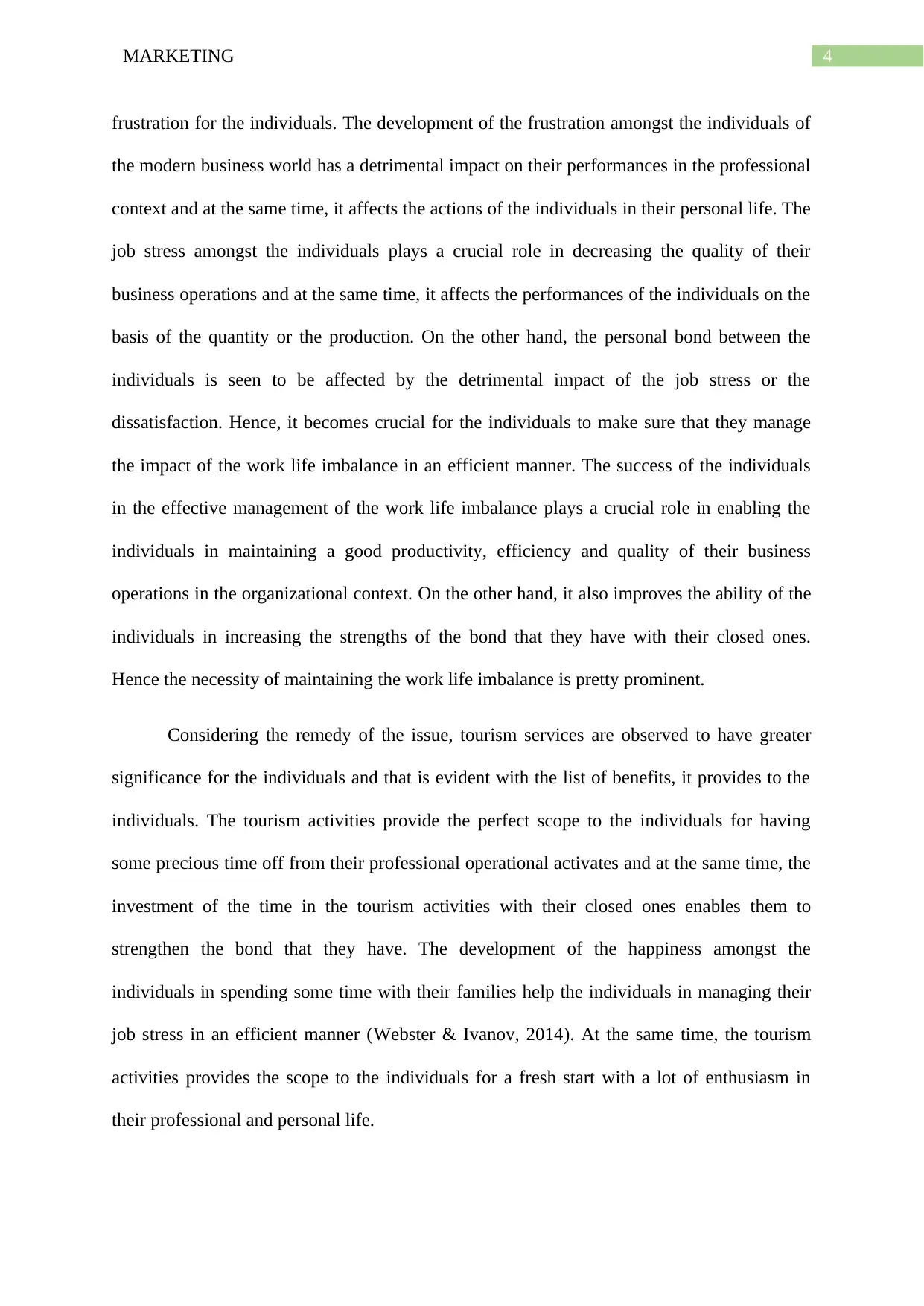
4MARKETING
frustration for the individuals. The development of the frustration amongst the individuals of
the modern business world has a detrimental impact on their performances in the professional
context and at the same time, it affects the actions of the individuals in their personal life. The
job stress amongst the individuals plays a crucial role in decreasing the quality of their
business operations and at the same time, it affects the performances of the individuals on the
basis of the quantity or the production. On the other hand, the personal bond between the
individuals is seen to be affected by the detrimental impact of the job stress or the
dissatisfaction. Hence, it becomes crucial for the individuals to make sure that they manage
the impact of the work life imbalance in an efficient manner. The success of the individuals
in the effective management of the work life imbalance plays a crucial role in enabling the
individuals in maintaining a good productivity, efficiency and quality of their business
operations in the organizational context. On the other hand, it also improves the ability of the
individuals in increasing the strengths of the bond that they have with their closed ones.
Hence the necessity of maintaining the work life imbalance is pretty prominent.
Considering the remedy of the issue, tourism services are observed to have greater
significance for the individuals and that is evident with the list of benefits, it provides to the
individuals. The tourism activities provide the perfect scope to the individuals for having
some precious time off from their professional operational activates and at the same time, the
investment of the time in the tourism activities with their closed ones enables them to
strengthen the bond that they have. The development of the happiness amongst the
individuals in spending some time with their families help the individuals in managing their
job stress in an efficient manner (Webster & Ivanov, 2014). At the same time, the tourism
activities provides the scope to the individuals for a fresh start with a lot of enthusiasm in
their professional and personal life.
frustration for the individuals. The development of the frustration amongst the individuals of
the modern business world has a detrimental impact on their performances in the professional
context and at the same time, it affects the actions of the individuals in their personal life. The
job stress amongst the individuals plays a crucial role in decreasing the quality of their
business operations and at the same time, it affects the performances of the individuals on the
basis of the quantity or the production. On the other hand, the personal bond between the
individuals is seen to be affected by the detrimental impact of the job stress or the
dissatisfaction. Hence, it becomes crucial for the individuals to make sure that they manage
the impact of the work life imbalance in an efficient manner. The success of the individuals
in the effective management of the work life imbalance plays a crucial role in enabling the
individuals in maintaining a good productivity, efficiency and quality of their business
operations in the organizational context. On the other hand, it also improves the ability of the
individuals in increasing the strengths of the bond that they have with their closed ones.
Hence the necessity of maintaining the work life imbalance is pretty prominent.
Considering the remedy of the issue, tourism services are observed to have greater
significance for the individuals and that is evident with the list of benefits, it provides to the
individuals. The tourism activities provide the perfect scope to the individuals for having
some precious time off from their professional operational activates and at the same time, the
investment of the time in the tourism activities with their closed ones enables them to
strengthen the bond that they have. The development of the happiness amongst the
individuals in spending some time with their families help the individuals in managing their
job stress in an efficient manner (Webster & Ivanov, 2014). At the same time, the tourism
activities provides the scope to the individuals for a fresh start with a lot of enthusiasm in
their professional and personal life.

5MARKETING
Considering the perspective of the educations, the significance of the tourism
activities is pretty prominent amongst the individuals. There are several educational institutes
which are observed to conduct educational tours to various tourism destinations for providing
the scope to the students in gaining the relevant information regarding their studies (Sheldon
and Fesenmaier, 2013). However, the preferences of the educational institutes regarding the
selection of tourism destinations is seen to differ on the form of studies that they are
selecting. For an example, if an educational institute has the expertise of providing the scope
to the individuals to participate in history course curriculum, then the preferences of the
institute regarding the selection if the destination is expected to be motivated by the historical
significance of the place. On the other hand, if an institute is dedicated in providing the scope
to the students for managing their science related course curriculum, then the selection of the
destination is expected to be influenced by the scientific significance of the destination.
Hence, the preferences amongst the customers are expected to be different on the basis of
their needs and that diversified preferences of the individuals incorporates the variety in the
customer segmentation and targeting.
Considering the segmentation of the customer profiles, it is evident that the
importance of the identifying the factors that have the capability to affect the purchase
intention of the customers, is notable. Neuts, Chen and Nijkamp (2016), claimed that, it is
important to understand the characteristics of the destinations as the findings have significant
impact on the customer segmentation and the development of the customer profiles. For
example, if the destination is considered to be luxurious and at the same time, it is designed
in such a manner that it provides the required scope to the customers belonging youth, in
meeting their tourism needs, then the pricing strategy for the destination is expected to be
designed in accordance to that and at the same time, the consideration of the pricing is
expected to be visible in the segmentation strategy applied for the mentioned destination. On
Considering the perspective of the educations, the significance of the tourism
activities is pretty prominent amongst the individuals. There are several educational institutes
which are observed to conduct educational tours to various tourism destinations for providing
the scope to the students in gaining the relevant information regarding their studies (Sheldon
and Fesenmaier, 2013). However, the preferences of the educational institutes regarding the
selection of tourism destinations is seen to differ on the form of studies that they are
selecting. For an example, if an educational institute has the expertise of providing the scope
to the individuals to participate in history course curriculum, then the preferences of the
institute regarding the selection if the destination is expected to be motivated by the historical
significance of the place. On the other hand, if an institute is dedicated in providing the scope
to the students for managing their science related course curriculum, then the selection of the
destination is expected to be influenced by the scientific significance of the destination.
Hence, the preferences amongst the customers are expected to be different on the basis of
their needs and that diversified preferences of the individuals incorporates the variety in the
customer segmentation and targeting.
Considering the segmentation of the customer profiles, it is evident that the
importance of the identifying the factors that have the capability to affect the purchase
intention of the customers, is notable. Neuts, Chen and Nijkamp (2016), claimed that, it is
important to understand the characteristics of the destinations as the findings have significant
impact on the customer segmentation and the development of the customer profiles. For
example, if the destination is considered to be luxurious and at the same time, it is designed
in such a manner that it provides the required scope to the customers belonging youth, in
meeting their tourism needs, then the pricing strategy for the destination is expected to be
designed in accordance to that and at the same time, the consideration of the pricing is
expected to be visible in the segmentation strategy applied for the mentioned destination. On
⊘ This is a preview!⊘
Do you want full access?
Subscribe today to unlock all pages.

Trusted by 1+ million students worldwide

6MARKETING
the other hand, if a destination is seen to have cultural significance associated with it, then the
segmentation of the customers and the application of the pricing strategy is expected to differ.
Hence, the uniformity regarding the customer segmentation and the development of target
market profile without precise identification of the tourism destination becomes
controversial. Having said that, a brief target segment and the customer profile is provided
below:
Demographics Medium impact High impact
Gender Both male and
female
Both male and
female
Income group 75000 to 95000
Singapore Dollars
100000 to 125000
Singapore Dollars
Age 40 years to 60 years 25 to 39 years
With a precise focus on the target market, it is evident that the preferences towards the
customers belonging the youth is considerably high and that have been the trend across the
globe. The tourism industries may that be the national or global, are observed record
considerable amount of revenue from the part of the customers belonging the youth. Demeter
and Bratucu (2014), claimed that the interest amongst the customers of the youth generation
regarding the purchase of the tourism services is seen to be highest in comparison to other
customer groups. At the same time, the repetitive purchase and higher order purchases which
play a crucial role in the increment of the revenue of the tourism companies, are observed to
be largely from the part of the customers belonging the youth generation. Hence, on the basis
of the frequent purchase of the services and the monetary expenditure conducted by the
the other hand, if a destination is seen to have cultural significance associated with it, then the
segmentation of the customers and the application of the pricing strategy is expected to differ.
Hence, the uniformity regarding the customer segmentation and the development of target
market profile without precise identification of the tourism destination becomes
controversial. Having said that, a brief target segment and the customer profile is provided
below:
Demographics Medium impact High impact
Gender Both male and
female
Both male and
female
Income group 75000 to 95000
Singapore Dollars
100000 to 125000
Singapore Dollars
Age 40 years to 60 years 25 to 39 years
With a precise focus on the target market, it is evident that the preferences towards the
customers belonging the youth is considerably high and that have been the trend across the
globe. The tourism industries may that be the national or global, are observed record
considerable amount of revenue from the part of the customers belonging the youth. Demeter
and Bratucu (2014), claimed that the interest amongst the customers of the youth generation
regarding the purchase of the tourism services is seen to be highest in comparison to other
customer groups. At the same time, the repetitive purchase and higher order purchases which
play a crucial role in the increment of the revenue of the tourism companies, are observed to
be largely from the part of the customers belonging the youth generation. Hence, on the basis
of the frequent purchase of the services and the monetary expenditure conducted by the
Paraphrase This Document
Need a fresh take? Get an instant paraphrase of this document with our AI Paraphraser
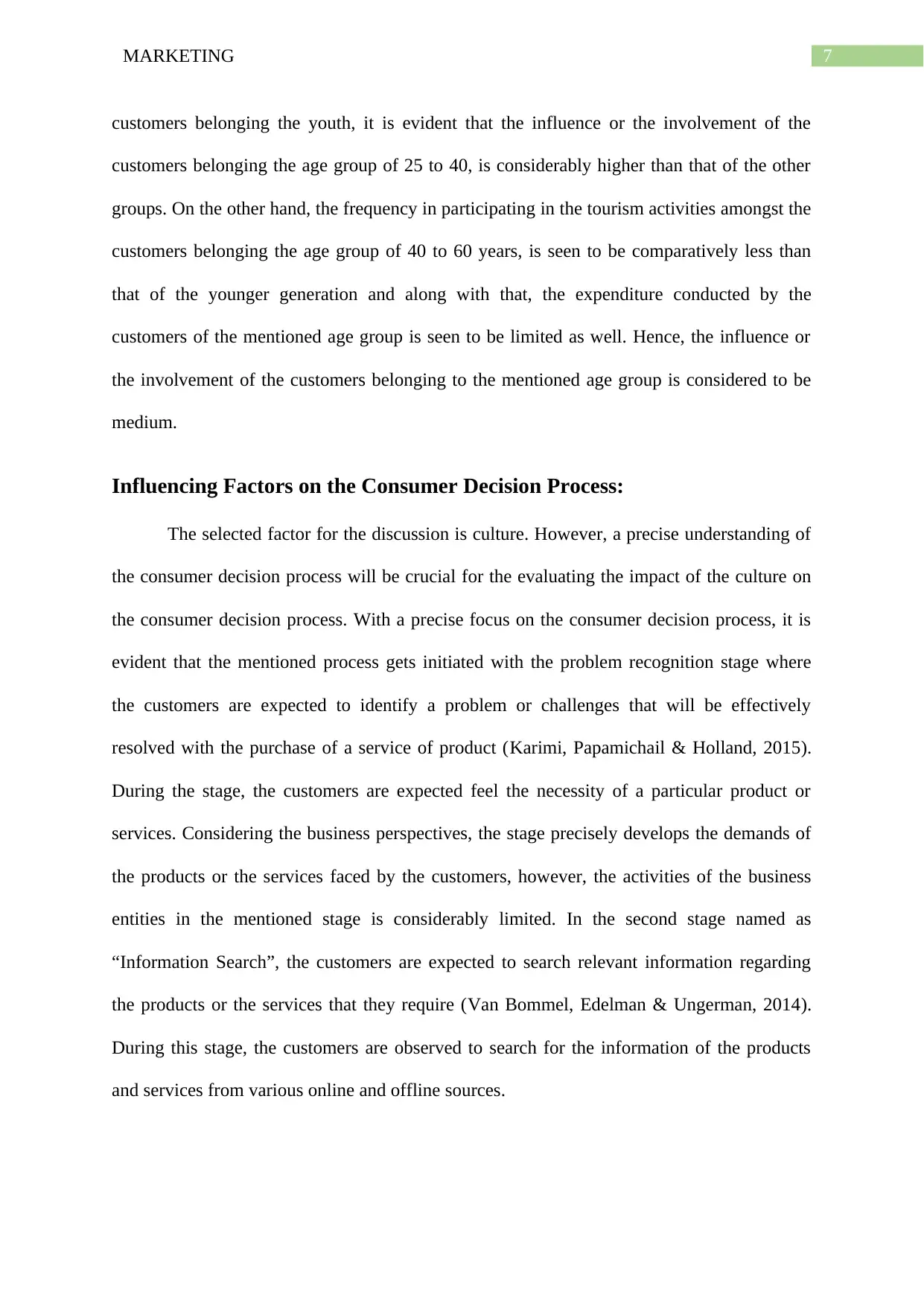
7MARKETING
customers belonging the youth, it is evident that the influence or the involvement of the
customers belonging the age group of 25 to 40, is considerably higher than that of the other
groups. On the other hand, the frequency in participating in the tourism activities amongst the
customers belonging the age group of 40 to 60 years, is seen to be comparatively less than
that of the younger generation and along with that, the expenditure conducted by the
customers of the mentioned age group is seen to be limited as well. Hence, the influence or
the involvement of the customers belonging to the mentioned age group is considered to be
medium.
Influencing Factors on the Consumer Decision Process:
The selected factor for the discussion is culture. However, a precise understanding of
the consumer decision process will be crucial for the evaluating the impact of the culture on
the consumer decision process. With a precise focus on the consumer decision process, it is
evident that the mentioned process gets initiated with the problem recognition stage where
the customers are expected to identify a problem or challenges that will be effectively
resolved with the purchase of a service of product (Karimi, Papamichail & Holland, 2015).
During the stage, the customers are expected feel the necessity of a particular product or
services. Considering the business perspectives, the stage precisely develops the demands of
the products or the services faced by the customers, however, the activities of the business
entities in the mentioned stage is considerably limited. In the second stage named as
“Information Search”, the customers are expected to search relevant information regarding
the products or the services that they require (Van Bommel, Edelman & Ungerman, 2014).
During this stage, the customers are observed to search for the information of the products
and services from various online and offline sources.
customers belonging the youth, it is evident that the influence or the involvement of the
customers belonging the age group of 25 to 40, is considerably higher than that of the other
groups. On the other hand, the frequency in participating in the tourism activities amongst the
customers belonging the age group of 40 to 60 years, is seen to be comparatively less than
that of the younger generation and along with that, the expenditure conducted by the
customers of the mentioned age group is seen to be limited as well. Hence, the influence or
the involvement of the customers belonging to the mentioned age group is considered to be
medium.
Influencing Factors on the Consumer Decision Process:
The selected factor for the discussion is culture. However, a precise understanding of
the consumer decision process will be crucial for the evaluating the impact of the culture on
the consumer decision process. With a precise focus on the consumer decision process, it is
evident that the mentioned process gets initiated with the problem recognition stage where
the customers are expected to identify a problem or challenges that will be effectively
resolved with the purchase of a service of product (Karimi, Papamichail & Holland, 2015).
During the stage, the customers are expected feel the necessity of a particular product or
services. Considering the business perspectives, the stage precisely develops the demands of
the products or the services faced by the customers, however, the activities of the business
entities in the mentioned stage is considerably limited. In the second stage named as
“Information Search”, the customers are expected to search relevant information regarding
the products or the services that they require (Van Bommel, Edelman & Ungerman, 2014).
During this stage, the customers are observed to search for the information of the products
and services from various online and offline sources.
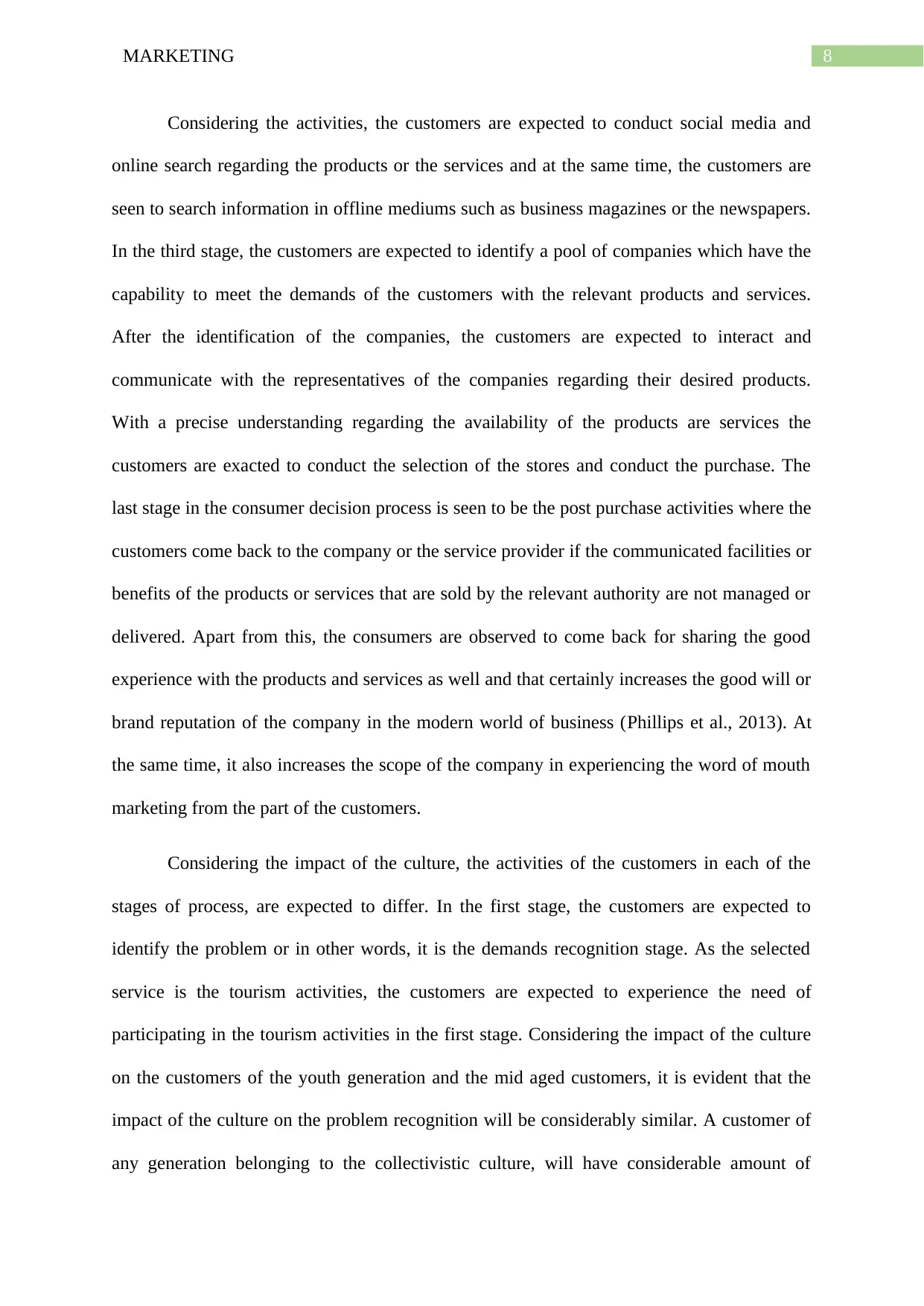
8MARKETING
Considering the activities, the customers are expected to conduct social media and
online search regarding the products or the services and at the same time, the customers are
seen to search information in offline mediums such as business magazines or the newspapers.
In the third stage, the customers are expected to identify a pool of companies which have the
capability to meet the demands of the customers with the relevant products and services.
After the identification of the companies, the customers are expected to interact and
communicate with the representatives of the companies regarding their desired products.
With a precise understanding regarding the availability of the products are services the
customers are exacted to conduct the selection of the stores and conduct the purchase. The
last stage in the consumer decision process is seen to be the post purchase activities where the
customers come back to the company or the service provider if the communicated facilities or
benefits of the products or services that are sold by the relevant authority are not managed or
delivered. Apart from this, the consumers are observed to come back for sharing the good
experience with the products and services as well and that certainly increases the good will or
brand reputation of the company in the modern world of business (Phillips et al., 2013). At
the same time, it also increases the scope of the company in experiencing the word of mouth
marketing from the part of the customers.
Considering the impact of the culture, the activities of the customers in each of the
stages of process, are expected to differ. In the first stage, the customers are expected to
identify the problem or in other words, it is the demands recognition stage. As the selected
service is the tourism activities, the customers are expected to experience the need of
participating in the tourism activities in the first stage. Considering the impact of the culture
on the customers of the youth generation and the mid aged customers, it is evident that the
impact of the culture on the problem recognition will be considerably similar. A customer of
any generation belonging to the collectivistic culture, will have considerable amount of
Considering the activities, the customers are expected to conduct social media and
online search regarding the products or the services and at the same time, the customers are
seen to search information in offline mediums such as business magazines or the newspapers.
In the third stage, the customers are expected to identify a pool of companies which have the
capability to meet the demands of the customers with the relevant products and services.
After the identification of the companies, the customers are expected to interact and
communicate with the representatives of the companies regarding their desired products.
With a precise understanding regarding the availability of the products are services the
customers are exacted to conduct the selection of the stores and conduct the purchase. The
last stage in the consumer decision process is seen to be the post purchase activities where the
customers come back to the company or the service provider if the communicated facilities or
benefits of the products or services that are sold by the relevant authority are not managed or
delivered. Apart from this, the consumers are observed to come back for sharing the good
experience with the products and services as well and that certainly increases the good will or
brand reputation of the company in the modern world of business (Phillips et al., 2013). At
the same time, it also increases the scope of the company in experiencing the word of mouth
marketing from the part of the customers.
Considering the impact of the culture, the activities of the customers in each of the
stages of process, are expected to differ. In the first stage, the customers are expected to
identify the problem or in other words, it is the demands recognition stage. As the selected
service is the tourism activities, the customers are expected to experience the need of
participating in the tourism activities in the first stage. Considering the impact of the culture
on the customers of the youth generation and the mid aged customers, it is evident that the
impact of the culture on the problem recognition will be considerably similar. A customer of
any generation belonging to the collectivistic culture, will have considerable amount of
⊘ This is a preview!⊘
Do you want full access?
Subscribe today to unlock all pages.

Trusted by 1+ million students worldwide
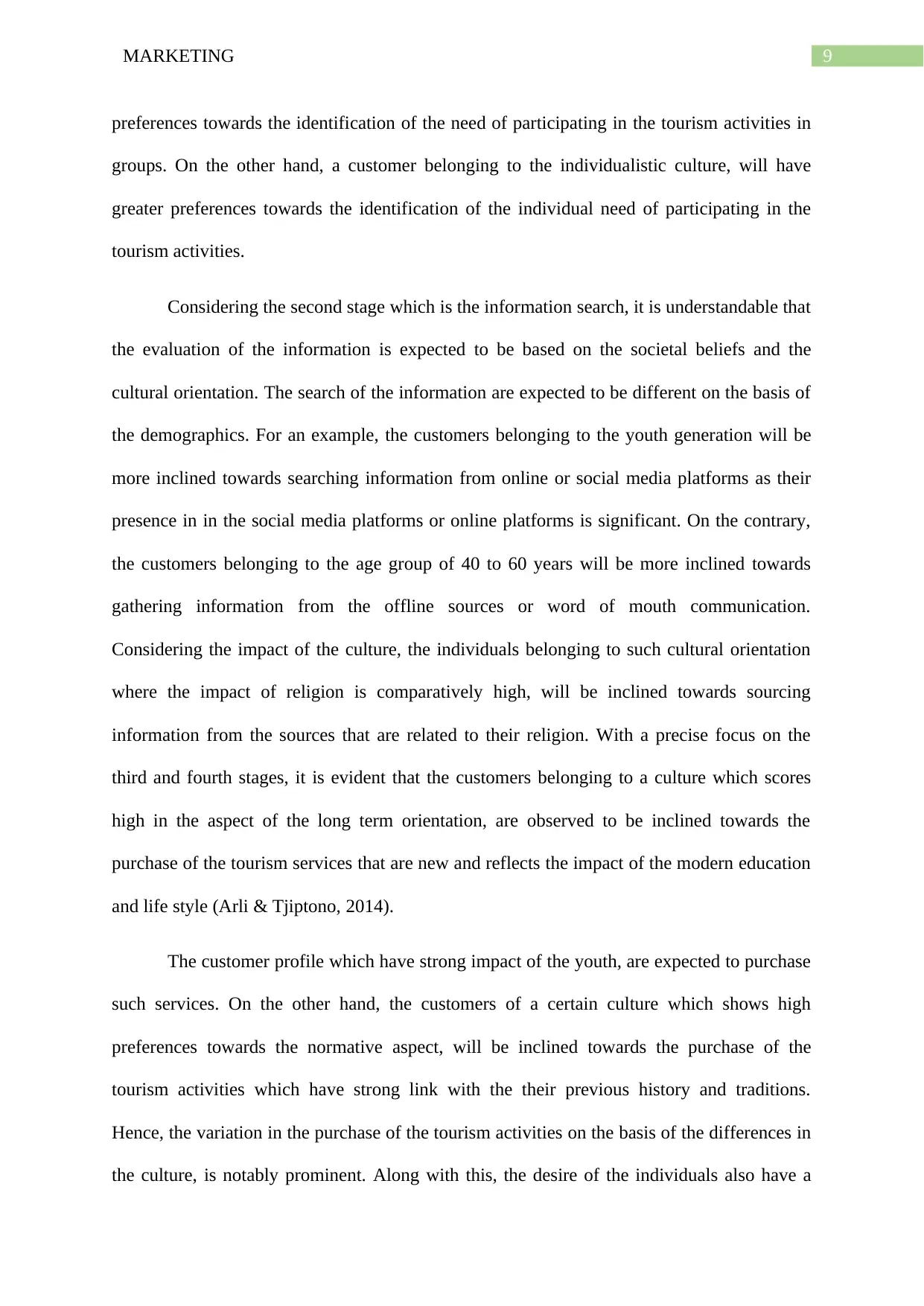
9MARKETING
preferences towards the identification of the need of participating in the tourism activities in
groups. On the other hand, a customer belonging to the individualistic culture, will have
greater preferences towards the identification of the individual need of participating in the
tourism activities.
Considering the second stage which is the information search, it is understandable that
the evaluation of the information is expected to be based on the societal beliefs and the
cultural orientation. The search of the information are expected to be different on the basis of
the demographics. For an example, the customers belonging to the youth generation will be
more inclined towards searching information from online or social media platforms as their
presence in in the social media platforms or online platforms is significant. On the contrary,
the customers belonging to the age group of 40 to 60 years will be more inclined towards
gathering information from the offline sources or word of mouth communication.
Considering the impact of the culture, the individuals belonging to such cultural orientation
where the impact of religion is comparatively high, will be inclined towards sourcing
information from the sources that are related to their religion. With a precise focus on the
third and fourth stages, it is evident that the customers belonging to a culture which scores
high in the aspect of the long term orientation, are observed to be inclined towards the
purchase of the tourism services that are new and reflects the impact of the modern education
and life style (Arli & Tjiptono, 2014).
The customer profile which have strong impact of the youth, are expected to purchase
such services. On the other hand, the customers of a certain culture which shows high
preferences towards the normative aspect, will be inclined towards the purchase of the
tourism activities which have strong link with the their previous history and traditions.
Hence, the variation in the purchase of the tourism activities on the basis of the differences in
the culture, is notably prominent. Along with this, the desire of the individuals also have a
preferences towards the identification of the need of participating in the tourism activities in
groups. On the other hand, a customer belonging to the individualistic culture, will have
greater preferences towards the identification of the individual need of participating in the
tourism activities.
Considering the second stage which is the information search, it is understandable that
the evaluation of the information is expected to be based on the societal beliefs and the
cultural orientation. The search of the information are expected to be different on the basis of
the demographics. For an example, the customers belonging to the youth generation will be
more inclined towards searching information from online or social media platforms as their
presence in in the social media platforms or online platforms is significant. On the contrary,
the customers belonging to the age group of 40 to 60 years will be more inclined towards
gathering information from the offline sources or word of mouth communication.
Considering the impact of the culture, the individuals belonging to such cultural orientation
where the impact of religion is comparatively high, will be inclined towards sourcing
information from the sources that are related to their religion. With a precise focus on the
third and fourth stages, it is evident that the customers belonging to a culture which scores
high in the aspect of the long term orientation, are observed to be inclined towards the
purchase of the tourism services that are new and reflects the impact of the modern education
and life style (Arli & Tjiptono, 2014).
The customer profile which have strong impact of the youth, are expected to purchase
such services. On the other hand, the customers of a certain culture which shows high
preferences towards the normative aspect, will be inclined towards the purchase of the
tourism activities which have strong link with the their previous history and traditions.
Hence, the variation in the purchase of the tourism activities on the basis of the differences in
the culture, is notably prominent. Along with this, the desire of the individuals also have a
Paraphrase This Document
Need a fresh take? Get an instant paraphrase of this document with our AI Paraphraser
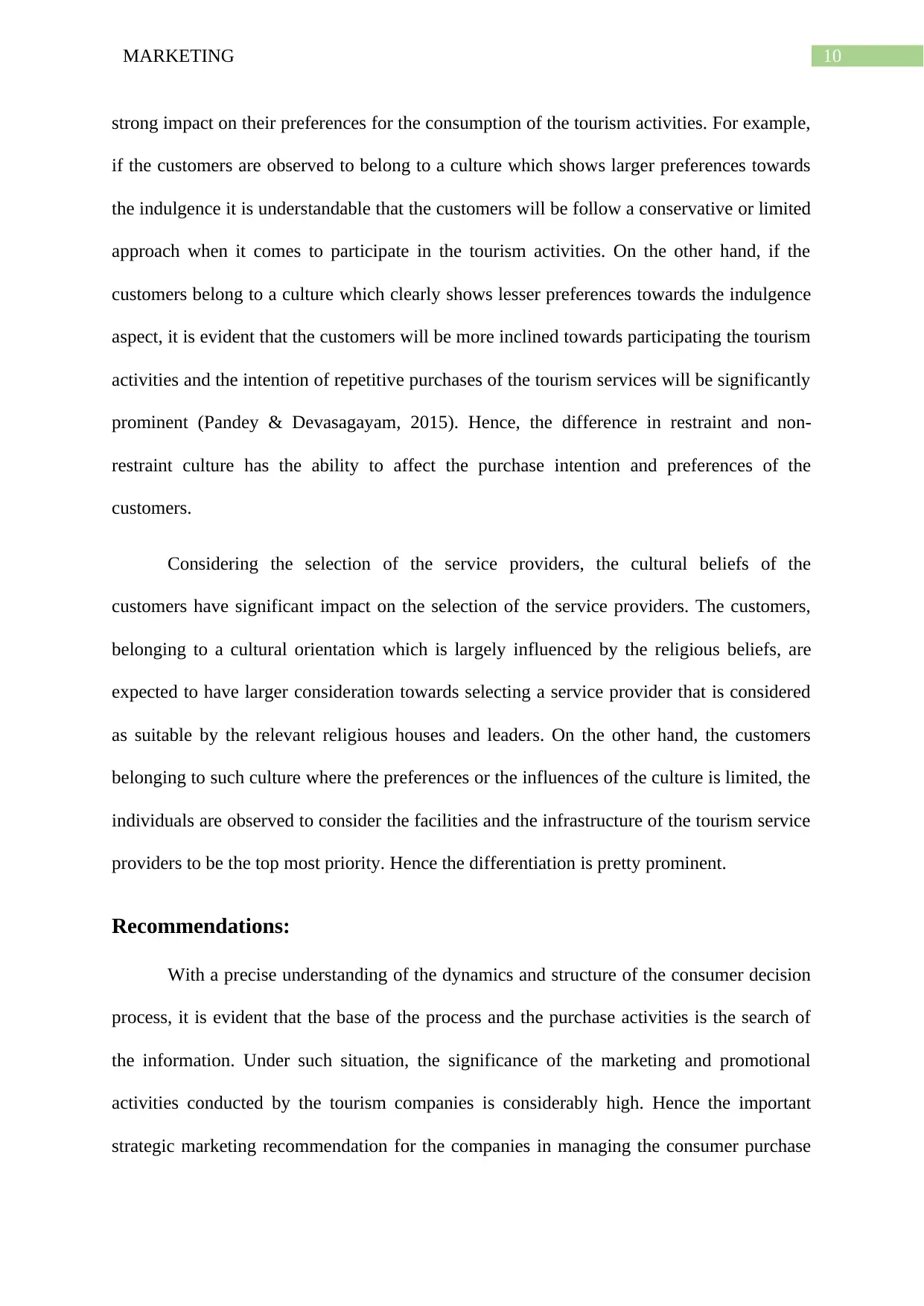
10MARKETING
strong impact on their preferences for the consumption of the tourism activities. For example,
if the customers are observed to belong to a culture which shows larger preferences towards
the indulgence it is understandable that the customers will be follow a conservative or limited
approach when it comes to participate in the tourism activities. On the other hand, if the
customers belong to a culture which clearly shows lesser preferences towards the indulgence
aspect, it is evident that the customers will be more inclined towards participating the tourism
activities and the intention of repetitive purchases of the tourism services will be significantly
prominent (Pandey & Devasagayam, 2015). Hence, the difference in restraint and non-
restraint culture has the ability to affect the purchase intention and preferences of the
customers.
Considering the selection of the service providers, the cultural beliefs of the
customers have significant impact on the selection of the service providers. The customers,
belonging to a cultural orientation which is largely influenced by the religious beliefs, are
expected to have larger consideration towards selecting a service provider that is considered
as suitable by the relevant religious houses and leaders. On the other hand, the customers
belonging to such culture where the preferences or the influences of the culture is limited, the
individuals are observed to consider the facilities and the infrastructure of the tourism service
providers to be the top most priority. Hence the differentiation is pretty prominent.
Recommendations:
With a precise understanding of the dynamics and structure of the consumer decision
process, it is evident that the base of the process and the purchase activities is the search of
the information. Under such situation, the significance of the marketing and promotional
activities conducted by the tourism companies is considerably high. Hence the important
strategic marketing recommendation for the companies in managing the consumer purchase
strong impact on their preferences for the consumption of the tourism activities. For example,
if the customers are observed to belong to a culture which shows larger preferences towards
the indulgence it is understandable that the customers will be follow a conservative or limited
approach when it comes to participate in the tourism activities. On the other hand, if the
customers belong to a culture which clearly shows lesser preferences towards the indulgence
aspect, it is evident that the customers will be more inclined towards participating the tourism
activities and the intention of repetitive purchases of the tourism services will be significantly
prominent (Pandey & Devasagayam, 2015). Hence, the difference in restraint and non-
restraint culture has the ability to affect the purchase intention and preferences of the
customers.
Considering the selection of the service providers, the cultural beliefs of the
customers have significant impact on the selection of the service providers. The customers,
belonging to a cultural orientation which is largely influenced by the religious beliefs, are
expected to have larger consideration towards selecting a service provider that is considered
as suitable by the relevant religious houses and leaders. On the other hand, the customers
belonging to such culture where the preferences or the influences of the culture is limited, the
individuals are observed to consider the facilities and the infrastructure of the tourism service
providers to be the top most priority. Hence the differentiation is pretty prominent.
Recommendations:
With a precise understanding of the dynamics and structure of the consumer decision
process, it is evident that the base of the process and the purchase activities is the search of
the information. Under such situation, the significance of the marketing and promotional
activities conducted by the tourism companies is considerably high. Hence the important
strategic marketing recommendation for the companies in managing the consumer purchase
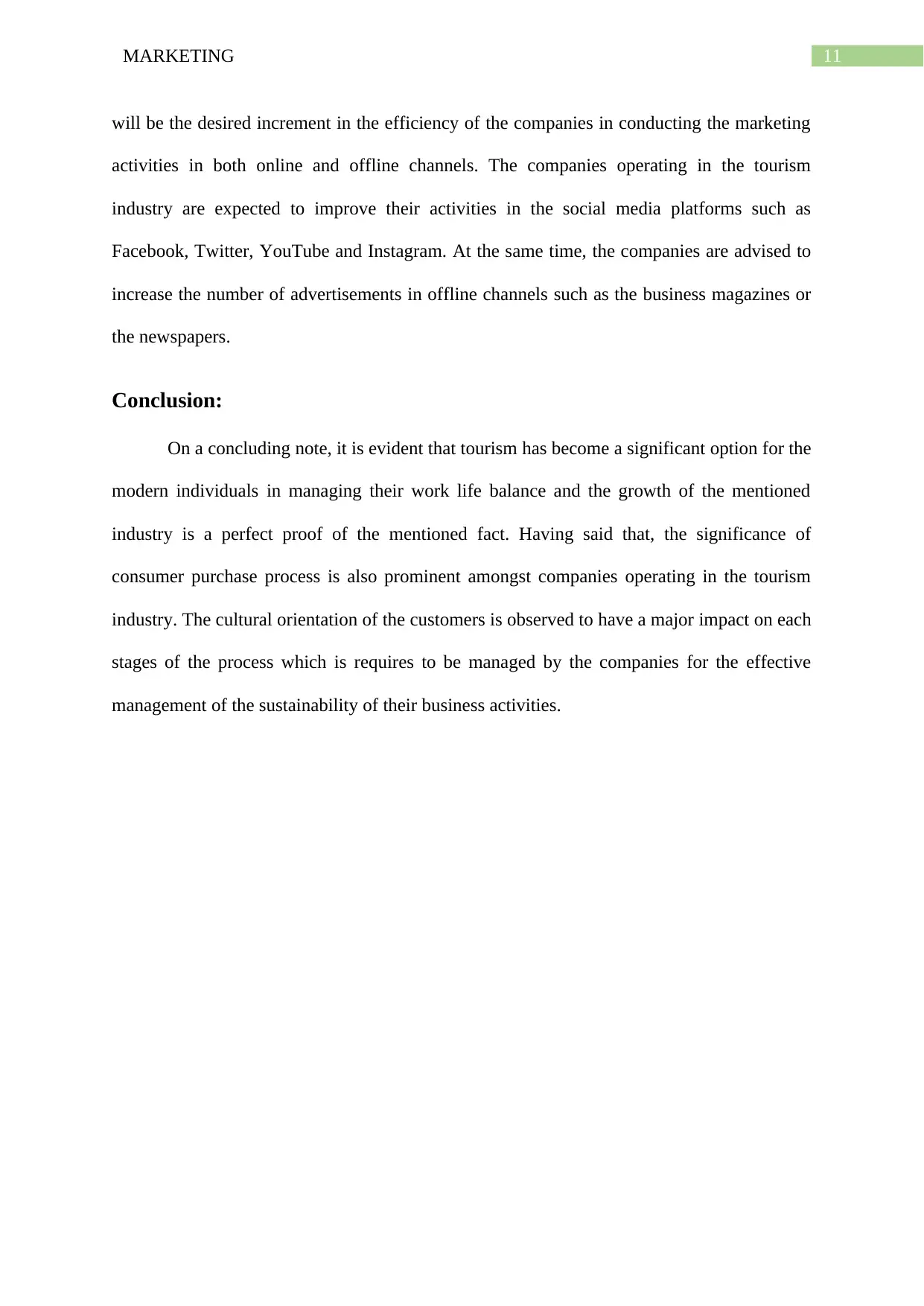
11MARKETING
will be the desired increment in the efficiency of the companies in conducting the marketing
activities in both online and offline channels. The companies operating in the tourism
industry are expected to improve their activities in the social media platforms such as
Facebook, Twitter, YouTube and Instagram. At the same time, the companies are advised to
increase the number of advertisements in offline channels such as the business magazines or
the newspapers.
Conclusion:
On a concluding note, it is evident that tourism has become a significant option for the
modern individuals in managing their work life balance and the growth of the mentioned
industry is a perfect proof of the mentioned fact. Having said that, the significance of
consumer purchase process is also prominent amongst companies operating in the tourism
industry. The cultural orientation of the customers is observed to have a major impact on each
stages of the process which is requires to be managed by the companies for the effective
management of the sustainability of their business activities.
will be the desired increment in the efficiency of the companies in conducting the marketing
activities in both online and offline channels. The companies operating in the tourism
industry are expected to improve their activities in the social media platforms such as
Facebook, Twitter, YouTube and Instagram. At the same time, the companies are advised to
increase the number of advertisements in offline channels such as the business magazines or
the newspapers.
Conclusion:
On a concluding note, it is evident that tourism has become a significant option for the
modern individuals in managing their work life balance and the growth of the mentioned
industry is a perfect proof of the mentioned fact. Having said that, the significance of
consumer purchase process is also prominent amongst companies operating in the tourism
industry. The cultural orientation of the customers is observed to have a major impact on each
stages of the process which is requires to be managed by the companies for the effective
management of the sustainability of their business activities.
⊘ This is a preview!⊘
Do you want full access?
Subscribe today to unlock all pages.

Trusted by 1+ million students worldwide
1 out of 15
Related Documents
Your All-in-One AI-Powered Toolkit for Academic Success.
+13062052269
info@desklib.com
Available 24*7 on WhatsApp / Email
![[object Object]](/_next/static/media/star-bottom.7253800d.svg)
Unlock your academic potential
Copyright © 2020–2025 A2Z Services. All Rights Reserved. Developed and managed by ZUCOL.





